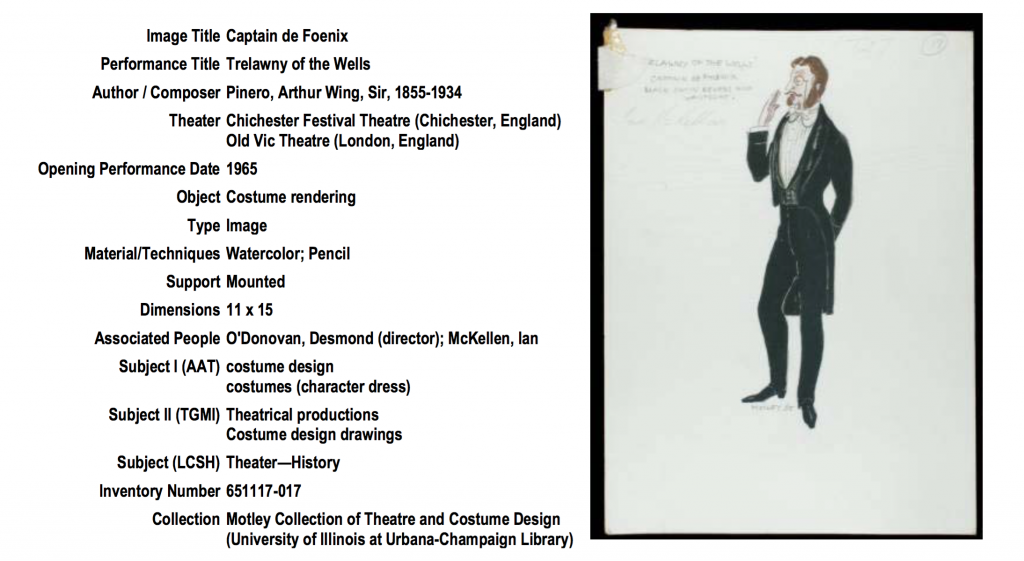This project will focus on implementing linked data to three special collections: Motley Collection of Theatre & Costume Design, The Kolb-Proust Archive for Research and Portraits of Actors Collection, 1720-1920. All three collections are part of the University Library at the University of Illinois at Urbana-Champaign.
Motley Collection of Theatre & Costume Design
The Motley Collection of Costume & Theatre Design, a unique and valuable source for documentation on the history of theatre that was purchased outright by the University of Illinois Library in 1981, includes more than 5,000 items, mostly original sketches for costume and set designs (all have now been digitized) used in over 150 productions at 61 different venues in the UK and the United States. About 49 of these 61 venues have a Wikipedia page, and some have specific production history pages.
 As illustrated in figure above, metadata for this collection is quite rich, referencing the actors who wore the costumes (e.g., Ian McKellen), the author of the play (e.g., Sir Arthur Wing Pinero), the director (e.g., Desmond O’Donovan), as well as the theatres in which the play was performed using the set or costume design. Two of the named entities from the figure do appear in VIAF (O’Donovan does not), but all three men are described in other Web sources, e.g., Wikipedia, IMDb, IBDB, etc. Though not all of these Web resources currently support LOD, they do have persistent URIs for entities that can be used as links. Similarly, the play, the character, the venues and the various performances of the play are referenced in multiple Web sources, and of course the script for the play itself is held by a number of libraries.
As illustrated in figure above, metadata for this collection is quite rich, referencing the actors who wore the costumes (e.g., Ian McKellen), the author of the play (e.g., Sir Arthur Wing Pinero), the director (e.g., Desmond O’Donovan), as well as the theatres in which the play was performed using the set or costume design. Two of the named entities from the figure do appear in VIAF (O’Donovan does not), but all three men are described in other Web sources, e.g., Wikipedia, IMDb, IBDB, etc. Though not all of these Web resources currently support LOD, they do have persistent URIs for entities that can be used as links. Similarly, the play, the character, the venues and the various performances of the play are referenced in multiple Web sources, and of course the script for the play itself is held by a number of libraries.
Portraits of Actors Collection, 1720-1920
The Portraits of Actors Collection, 1720 – 1920, includes more than 3,500 studio portraits of actors posing in costume for a particular role or performing a scene from a play. To help provide a more complete view of historic play performances, the collection also includes portraits of dramatists, theatrical managers, singers and musicians, but the majority of the portraits are of British and American actors who worked between about 1770 and 1893. The images in this collection were digitized from etchings, engravings, lithographs, mezzotints, aquatints, wood engravings, photographs, and photo-mechanically-reproduced prints, all from the University of Illinois Theatrical Print Collection.
The Motley and Portraits collections are complementary in time spans covered, but also in another, more nuanced way. The Motley collection comprises the working, unpublished records of a design group, whereas the items in the Portraits of Actors Collection were all published or destined for mass consumption. The images in the Portraits of Actors Collection are among the earliest examples of the mass production of celebrity images, in many ways the forerunners to Us Magazine and Entertainment Tonight. Entities such as individuals (actors, directors) and specific performances (venues and dates) should make it possible to link many of these digitized portraits to announcements and reviews of performances increasingly to be found online in digitized national and regional press repositories.
These collections today are of interest to many scholarly and lay users, including theater historians and biographers and performing arts and theater professionals such as costume and set designers doing research for current and future productions. Motley images have been licensed for inclusion in Shakespeare textbooks and we have anecdotal evidence26 that these images are used in classroom settings and for course projects.
In transforming the metadata for these collections, it will be a challenge to adapt the lessons learned in transforming MARC metadata and Early Modern Emblem-level metadata (Cole et al., 2013) to the distinctive metadata schemas of these collections. To meet this challenge, we will identify and integrate into our workflows new authorities from both library and non- library sources. We anticipate that what we learn and strategies used will be of interest to and potentially adaptable for transforming metadata of other digitized special collections.
Visit the Portrait of Actors collection
The Kolb-Proust Archive for Research
The digitized documents that comprise the Kolb-Proust Archive for Research (Szylowicz and Kibbee, 2004) are different from the two collections discussed above. These are not primary sources themselves but rather are an archive of raw scholarly output, representing an extensive body of scholarly research notes compiled over fifty years by Philip Kolb, a University of Illinois faculty member and the editor of Marcel Proust’s correspondence. These notes provide context for and descriptions of Proust’s correspondence and publications. They identify individuals, places and events mentioned in Proust’s letters. A selection of these notes were then “distilled” into the critical apparatus of the print edition of Proust’s correspondence (Paris, Plon, 1970-1993, 21 volumes).
Kolb’s research files, about 40,000 methodically cross-referenced index cards, can be understood as a first layer of metadata around the primary sources that are Proust letters and manuscripts, a map of his literary and cultural universe. The Archive contains considerably more data than Kolb was able to fit in the print edition, and draw from known letters, biographical sources, newspapers and other periodicals of the time, social directories, etc.
Kolb, one of the first scholars to do research on Proust also obtained unpublished information directly from Proust’s contemporaries (Proust died in 1922 at age 51) and consigned those details to his files.
The digitization and encoding of Kolb’s research notes adds a second layer of useful metadata and authority control: all cited individuals have been assigned a unique identifier, all literary and creative works cited have been assigned a genre category (fiction, poetry, music, sculpture, etc.), and all bibliographic references were standardized, which will facilitate linking these metadata to resources such as digitized newspapers (most French press of the time have been scanned and made available by the BnF28) and other digital surrogates (digitized books, and image or sound repositories, and Proust’s own manuscripts, also digitized and hosted by the BnF29).
The local name authority file created for the Kolb-Proust Archive augments name strings with dates (birth, death, marriage, etc.), and includes notes on profession and/or kinship. In reconciling names with external authorities, this ancillary information associated with each name will facilitate identification and disambiguation. In the current interface, our local authority file serves also as an index and has become a biographical resource of its own, from which users can link back to name mentions in the Kolb-Proust papers. We will leverage these metadata to help users link out to other resources, including non-bibliographic repositories: genealogical sources, and institutional sites such as the official records of the Legion of Honor or the French Ministry of Defense database listing all WWI casualties. There is also a growing body of other digitized vital records resources. Though most do not currently include LOD descriptions of entities indexed, we anticipate the potential for user- contributed annotations linking names found in the Kolb-Proust Archive to entries in these additional sources.
